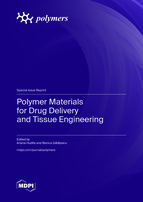Polymer Materials for Drug Delivery and Tissue Engineering
A special issue of Polymers (ISSN 2073-4360). This special issue belongs to the section "Polymer Applications".
Deadline for manuscript submissions: closed (25 November 2022) | Viewed by 47680
Special Issue Editors
Interests: nanoscaled drug delivery nanoscaled drug delivery systems; tumor-on-chip systems; colorectal cancer research; regenerative medicine; tissue engineering
Special Issues, Collections and Topics in MDPI journals
Interests: colon cancer research; nanoscaled drug delivery systems; tumor-on-chip; liquid biopsy; pharmacogenomics; personalized medicine
Special Issues, Collections and Topics in MDPI journals
Special Issue Information
Dear Colleagues,
The recent years have witnessed an impressive development of modern therapies because of the appearance of numerous novel drug-delivery systems and biomaterials synthetized for tissue engineering purposes. The use of polymer-based biomaterials (natural, synthetic, or blends) has played a pivotal role in the tremendous advances reported in the biomedical field because of their tailorable designs, versatility, attractive physiochemical properties, and excellent biocompatibility. On the one hand, polymer-based materials are widely used in tissue engineering for the design and fabrication of biomimetic scaffolds that resemble the complex architecture of the defective tissues, which are easily engineered to exert distinct biological functions. On the other hand, polymers have been used for drug and gene delivery systems fabrication because of their ability to carry both hydrophilic and hydrophobic drugs or other molecules, with a controlled release of controllable doses, that can be biofunctionalized to ensure the efficient delivery of pharmacological cargo to the desired site. Moreover, functional polymer-based biomaterials with dual function, scaffolds, and delivery vehicles for therapeutic agents and biological cues are currently an attractive modern approach in regenerative medicine. Independent of the targeted application, smart polymers currently represent a popular choice in the biomedical field, as these stimuli-responsive materials can adapt to the biological environment, thus providing a real opportunity for designing personalized biomedical products.
This Special Issue titled “Polymer Materials for Drug Delivery and Tissue Engineering” will focus on the recent development of polymeric materials intended for tissue engineering or drug-delivery applications. In this regard, we warmly invite members of the academic and scientific communities to contribute original papers, short communications, or reviews on the development, characterization, and possible biological applications of polymer-based biomaterials, with applications in drug delivery and tissue engineering. The purpose of this Special Issue is to gather cutting-edge research and new insights into polymer-based biomaterial progress in terms of novel and innovative methods of synthesis and functionalization, as well as modern approaches for in vitro and in vivo biological effect investigations.
Dr. Ariana Hudita
Dr. Bianca Gǎlǎţeanu
Guest Editors
Manuscript Submission Information
Manuscripts should be submitted online at www.mdpi.com by registering and logging in to this website. Once you are registered, click here to go to the submission form. Manuscripts can be submitted until the deadline. All submissions that pass pre-check are peer-reviewed. Accepted papers will be published continuously in the journal (as soon as accepted) and will be listed together on the special issue website. Research articles, review articles as well as short communications are invited. For planned papers, a title and short abstract (about 100 words) can be sent to the Editorial Office for announcement on this website.
Submitted manuscripts should not have been published previously, nor be under consideration for publication elsewhere (except conference proceedings papers). All manuscripts are thoroughly refereed through a single-blind peer-review process. A guide for authors and other relevant information for submission of manuscripts is available on the Instructions for Authors page. Polymers is an international peer-reviewed open access semimonthly journal published by MDPI.
Please visit the Instructions for Authors page before submitting a manuscript. The Article Processing Charge (APC) for publication in this open access journal is 2700 CHF (Swiss Francs). Submitted papers should be well formatted and use good English. Authors may use MDPI's English editing service prior to publication or during author revisions.
Keywords
- Bioinspired implantable materials
- Nanoshuttles
- Polymeric drug delivery systems
- Tissue engineering
- Regenerative medicine
- Non-viral vectors
- Modern biomedicine








